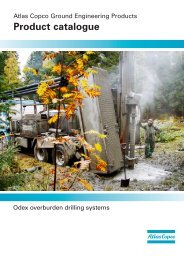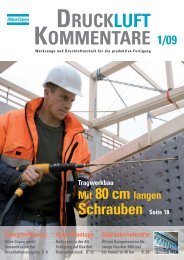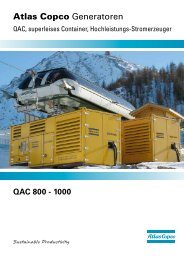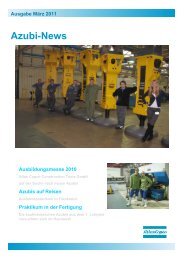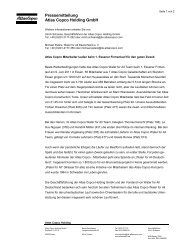Industrial Power Tools 2010-11 - Atlas Copco
Industrial Power Tools 2010-11 - Atlas Copco
Industrial Power Tools 2010-11 - Atlas Copco
Create successful ePaper yourself
Turn your PDF publications into a flip-book with our unique Google optimized e-Paper software.
<strong>Power</strong> Focus 4000 series Controllers<br />
Spindle synchronization<br />
All <strong>Atlas</strong> <strong>Copco</strong> tightening spindles are<br />
easily fixtured using our standard range<br />
of Express mechanics. The StepSync<br />
and SynchroTork tightening strategies<br />
give various levels of spindle synchronization<br />
during clamp force build-up. Communication<br />
between the controllers in the<br />
cell or group takes place via the I/O bus.<br />
Depending on user-interface preferences<br />
and budget, the SyncMaster may be a<br />
Compact or Graph hardware unit.<br />
MultiStage functionality reduces<br />
relaxation<br />
The inherent “MultiStage” functionality<br />
permits the combination of up to eight<br />
different parameter sets in a linear sequence.<br />
The entire process is activated<br />
with just one press of the tool trigger.<br />
For joint conditioning, fasteners can be<br />
run down to a pre-torque value, backed<br />
off by a configurable number of degrees<br />
and then re-tightened to the desired final<br />
torque. This advanced functionality is<br />
ideal for reducing relaxation in a joint.<br />
Cell networking gives process security<br />
The Cell concept allows for Ethernet networking<br />
without a PC, and offers overall<br />
station process control at a lower cost.<br />
A Cell consists of up to 20 units, where<br />
Integrated ways to communicate<br />
Controller level<br />
Realtime communication over I/O bus independent<br />
of the factory net.<br />
Fieldbus level<br />
The common industry field buses are<br />
supported, for example Profibus, Ethernet<br />
IP and FL-Net.<br />
Cell level<br />
The cell is a key concept in the system<br />
design. It is a cluster of max. 20 controllers<br />
networked together via built-in Ethernet<br />
TCP/IP. No need for use of a PC.<br />
Factory level<br />
<strong>Power</strong> Focus can be integrated with the<br />
factory Ethernet network which enables<br />
easy access and reporting anywhere in<br />
the plant.<br />
Internet level<br />
Worldwide communication is a matter of<br />
giving access through a factory network<br />
gateway to <strong>Power</strong> Focus.<br />
Tensor spindles are easily fixtured using our standard range of Express mechanics.<br />
The control strategies StepSync and SynchroTork synchronize Tensor spindles to<br />
provide consistent clamp forces over the entire component mating face.<br />
the Master controls the process of all<br />
Members in the tightening station, and<br />
communicates process data as a single<br />
interface point.<br />
Advanced statistics for better quality<br />
control<br />
Data is continuously collected and analyzed,<br />
and can be presented as statistics<br />
on, e.g., the Graph color display. Diagnostics<br />
and statistical alarms such as<br />
SPC monitor charts, and capability (Cpk)<br />
alarms highlight changes and trends in<br />
the assembly process. Effective information<br />
and SPC are good motivators, and<br />
encourage operators to adopt a proactive<br />
approach to monitoring the quality of the<br />
assembly process.<br />
Discrete I/O, I/O bus, Fieldbus, Compact, Graph, PC, access router, host database.<br />
Electric Assembly <strong>Tools</strong> and Systems 131<br />
Controllers and Software



